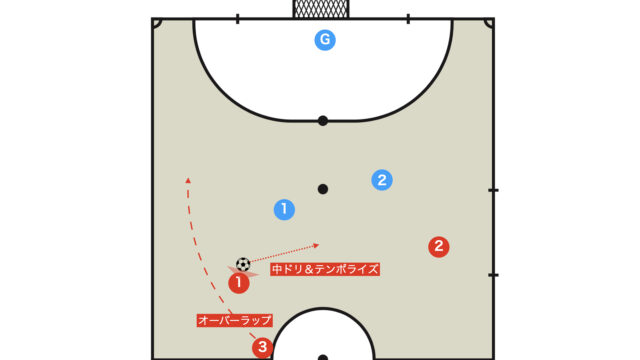What is Transition?
Transition is Part of the Four Main Phases
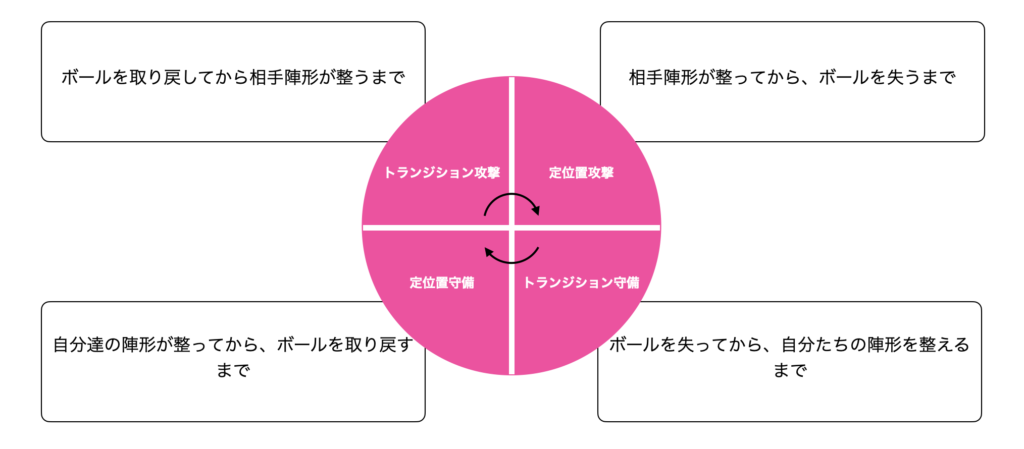
Transition is the phase in which the switch between positional attack and positional defence occurs.
- Attacking Transition = Positive Transition = Counter
- Defensive Transition = Negative Transition = Being Countered
In futsal, it is said that goals resulting from transitions are the most frequent among all phases, and it is sometimes said that he who controls transition controls futsal, underscoring the phase’s critical importance.
The ease of scoring from transitions can mainly be attributed to the following three factors:
- A chaotic state where organization is lacking
- A tendency for numerical imbalance (advantage or disadvantage) to occur
- More space available per player
Among these, the element that leverages numerical advantage is considered most significant.
It is said that the key to controlling the transition opening is the speed of switching.
Transition is not always the phase in which the most goals are scored in futsal. In some cases, set-pieces or positional play may yield more goals. However, research based on data from many matches has shown that goals tend to be scored more frequently from transitions.
Breakdown into Sub-phases (Secondary Phases)
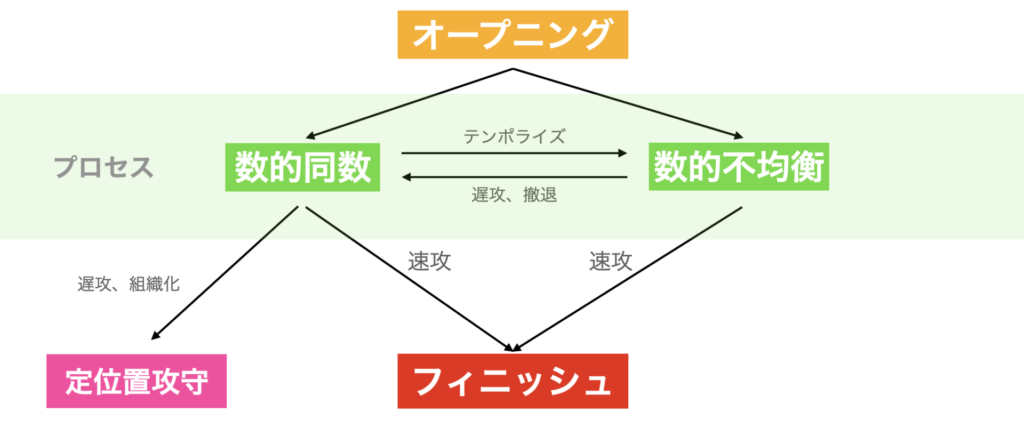
The transition phase is broadly classified into three parts: opening, process (either numerical equality or numerical imbalance), and finish.
Among these, the opening is the most crucial phase, and it is no exaggeration to say that those who master the opening control the transition.
The Essence of Transition
Crisis and Opportunity Are Two Sides of the Same Coin (Crisis ⇔ Opportunity)
Even if the ball possession changes during a state of numerical imbalance, the imbalance itself remains essentially intact as the roles of attack and defence are reversed.
A team in crisis becomes an opportunity, while a team with the advantage eventually finds itself in a crisis.
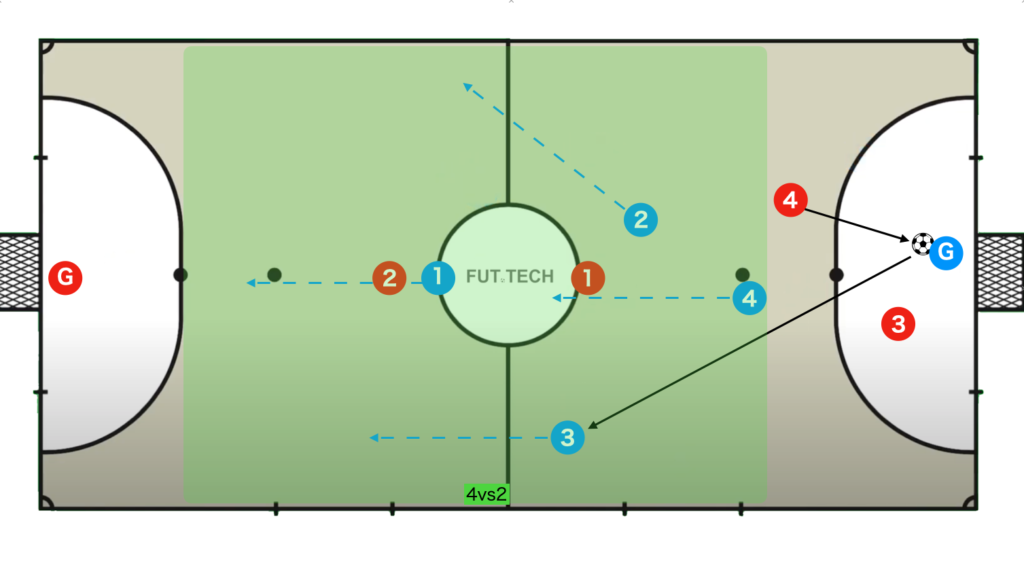
The above diagram shows an example where the attacking side, in a 2vs0 situation, had a shot caught by the goleiro.
If the goleiro throws the ball forward, the situation shifts from 2vs0 to 2vs4.
Thus, it is important to approach transition with the understanding that crisis and opportunity are always two sides of the same coin.
For this reason, this blog explains attacking transition and defensive transition together.
Switching Speed
The phrase “let’s switch quickly” is one you hear so often in teams that it almost becomes a cliché; however, what exactly does switching speed mean and what is required to improve it?
Switching speed is the ability to change your mindset in anticipation of the next phase and to initiate the appropriate play.
Anticipate the Situation and Take Appropriate Positioning Before It Occurs
If you assume the appropriate positioning before the situation arises, you don’t need to retreat in a hurry to win back the ball, and you can quickly transition to a counter-attack.

In futsal attacking in the opponent’s half, there is a concept known as the finish triangle, and players in the rebound position are particularly crucial in controlling the transition opening.
Specifically, if after a shot the goleiro deflects the ball in front of the goal, a chaotic and unstructured situation ensues, thereby triggering an actual transition.
Whether you reach the loose ball first or can immediately press if the opponent gets to it depends on having that rebound position.
In addition, do not forget to position one player at the back to maintain balance.
In other words, forming a finish triangle (triangle + 1) is extremely important for controlling the transition opening.
Develop the Habit of Reacting Reflexively (Feel Before You Think)
Once a habit is formed, people tend to feel uneasy if they don’t follow it.
By utilizing this principle and making it a habit to, except when a goal is scored, immediately return to your own half and try to reclaim the ball as soon as it is lost, your body will naturally react without needing to think.
Since the transition phase is a chaotic situation where every 0.1 second counts, it is already too late if you think before acting. Therefore, it is important to “install” a program in your body that enables you to feel and react reflexively before you even think.
This isn’t something that can be achieved merely by saying “let’s switch faster”—it must be consciously practiced and ingrained through daily training.
Bringing Order Within Chaos
Even if you develop the habit of retreating and outpacing your teammates, it is meaningless if you do not know exactly where to go.
It is important to analyze each specific situation and understand and execute the appropriate action accordingly.
In other words, it means deciding on and implementing a team play model (tactics) for transition.
Types of Transition
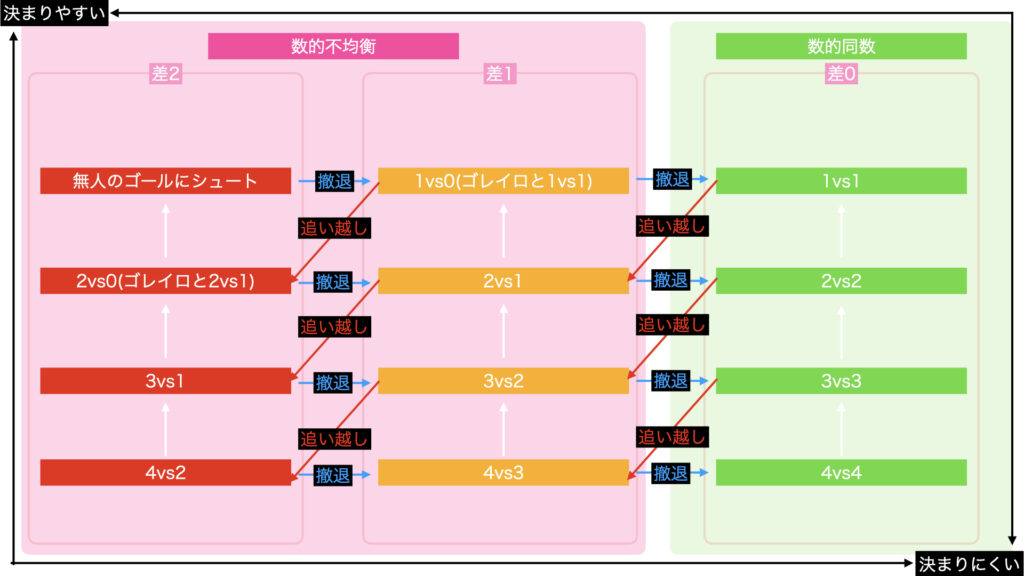
When subdividing transitions based on the number of players in front of the ball line, they can be classified as shown in the diagram above.
- Numerical Equality (1vs1, 2vs2, 3vs3, 4vs4)
- Numerical Imbalance, Difference of 1 (1vs0, 2vs1, 3vs2, 4vs3)
- Numerical Imbalance, Difference of 2 (2vs0, 3vs1, 4vs2)
They are largely divided into three groups, and the situation evolves based on the opponent’s retreat and your team’s outpacing.
In this diagram, the further up and to the left you go, the more likely a goal is to be scored, whereas the further down and to the right, the less likely a goal becomes.
In other words, the attack should aim for the top-left phase, while defence should aim for the bottom-right phase.
Numerical Equality
The numerical equality phase is one in which goals are very unlikely, so a decision must be made either to press on for a finish or to deliberately delay the attack (slow attack).
Additionally, by waiting for your teammates to advance (temporize) and creating a situation of numerical advantage, the chances of scoring can be significantly increased.
You must make the optimal decision by assessing the flow and situation of the game.
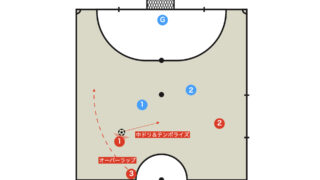
When your teammates advance faster than the opponent retreats, the ball holder intentionally refrains from rushing the attack in order to wait, thereby creating time.
This increases the number of players on your side and significantly boosts the chances of scoring.
Numerical Imbalance
Difference of 1 (1vs2, 2vs3, 3vs4)
This phase is one where differences in team quality tend to manifest and it occurs frequently during matches.
If you want to focus on transitions, this is the phase you should address first.

Difference of 2 (2vs0, 3vs1)
While this is a situation where the attacking side holds an overwhelming advantage, it is surprisingly deep and often underestimated.
Failing to convert this phase and getting caught in a counter-counter can result in conceding a goal – a pattern that typically costs two goals and inflicts significant mental damage.

Thank you very much for reading this article to the end.
If you found this article useful, please consider sharing it using the social media share buttons above.
We regularly share valuable insights on futsal tactics on Twitter, so if you haven’t followed us yet, we’d appreciate your support!
We are committed to raising the level of futsal in Japan by sharing high-quality information through discussions with individuals who have coaching experience in the F.League and overseas.
If you have any questions or notice any mistakes, feel free to leave a comment below.
We update our articles regularly, so if you’d like to keep reading, please bookmark our site or search for “FutTech”!

